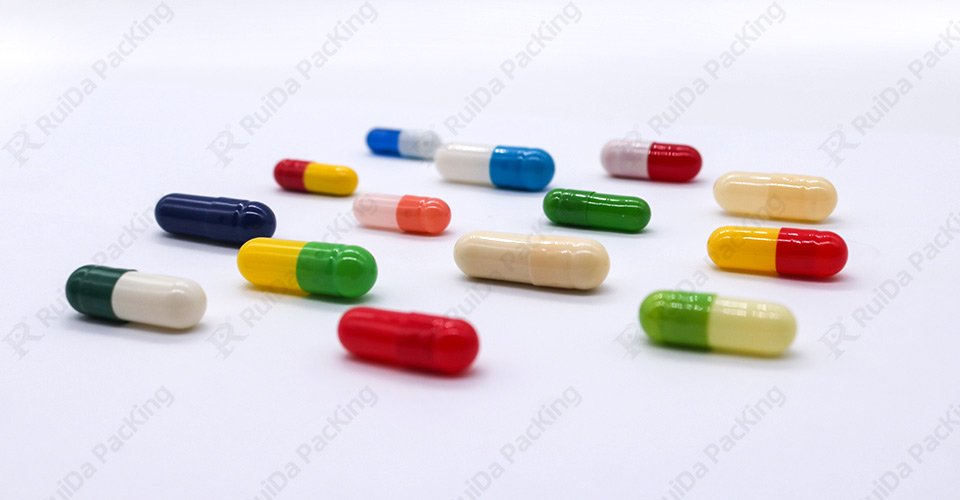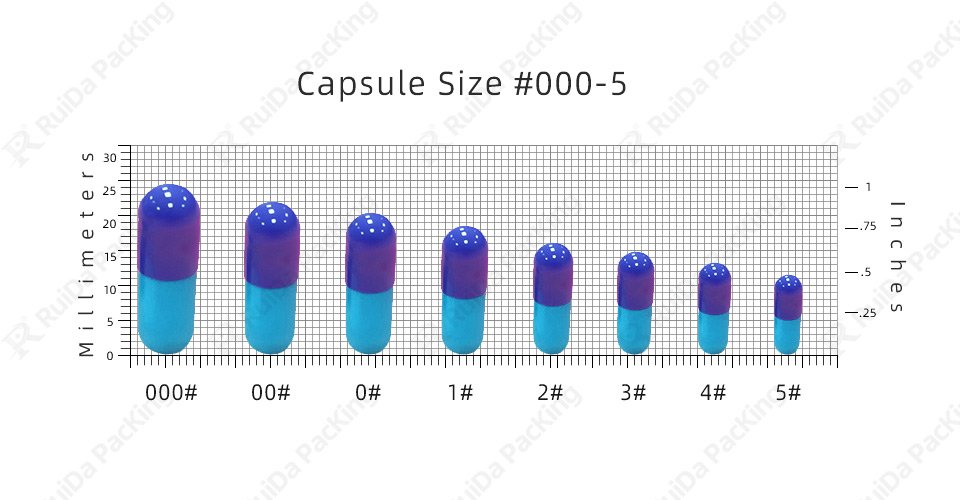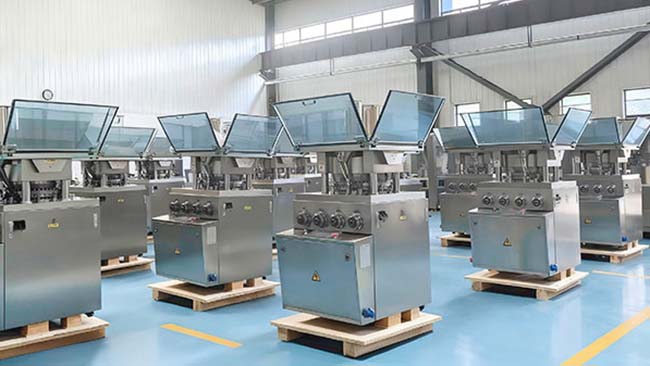
最も一般的なカプセルのサイズは何ですか?
最も一般的なカプセルサイズを理解することは、製品が市場の需要を満たすための第一歩です。医薬品およびサプリメント業界では、標準的なカプセルサイズは通常、#000、00、0、1、2、3、4、5のように数字で表記されます。000が最大サイズで、5が最小サイズです。これらのサイズは、ほとんどの国際的な製薬会社で広く使用されています。 カプセル充填機メーカー優れた互換性を提供します。以下は000から5までのカプセルサイズの比較表です。製品の具体的なニーズに合わせて最適なサイズをお選びいただけます。| カプセルサイズ | 000 | 00 | 0 | 1 | 2 | 3 | 4 | 5 |
| 空のカプセル容量 (ミリリットル) | 1.37 | 0.95 | 0.68 | 0.5 | 0.37 | 0.3 | 0.21 | 0.13 |
| 空カプセル重量(ゼラチン) (mg) | 158 | 123 | 97 | 76 | 63 | 52 | 42 | 33 |
| 空のカプセルの重量 (ベジタリアン)(mg) | 163 | 128 | 102 | 80 | 65 | 54 | 44 | 35 |
| 密度式による重量容量y (mg) | 800 – 1600 | 600 – 1200 | 400 – 800 | 300 – 600 | 250 – 500 | 200 – 400 | 150 – 300 | 100 – 200 |
| カプセル全長 (ミリメートル) | 26.14 | 23.3 | 21.7 | 19.4 | 18 | 15.9 | 14.3 | 11.1 |
| カプセルの長さ(キャップ) (ミリメートル) | 12.92 | 11.8 | 10.85 | 9.98 | 9 | 8.12 | 7.21 | 6.6 |
| 個々のカプセルの長さ(本体) (ミリメートル) | 23.3 | 20.22 | 18.75 | 16.5 | 15.4 | 13.6 | 12.2 | 10.8 |
適切なカプセルサイズを選択することがなぜ重要なのでしょうか?
カプセルのサイズは、医薬品やサプリメントの容量を決定するだけでなく、生産効率や空カプセルの総コストにも影響します。さらに重要なのは、消費者の飲み込みやすさに大きく影響する可能性があることです。000サイズのような大きなカプセルは、より多くの成分を含有できますが、高齢者、子供、嚥下困難のある方など、特定の消費者層にとっては飲み込みにくい場合があります。こうした方々には、3サイズや4サイズのような小さなカプセルの方が、はるかに受け入れられやすい場合が多いのです。
製品に適したカプセルのサイズを選択するにはどうすればよいでしょうか?
適切なカプセルサイズを選ぶには、いくつかの要素を考慮する必要があります。まず、製品の配合、投与量、そしてターゲット層を評価することから始めます。例えば、高用量の粉末サプリメントを扱っている場合は、00や000といったサイズの大きいカプセルが必要になるかもしれません。一方、微量元素サプリメントのような低用量の処方の場合は、1や2といったサイズの方が適しているかもしれません。
カプセルを摂取する状況を考慮することも重要です。例えば、子供や高齢者は飲み込みやすさから小さめのカプセルを好む傾向がありますが、健康な成人は大きめのカプセルを好む傾向があります。

ゼラチンカプセルとベジタリアンカプセルの違いは何ですか?
カプセルを選ぶ際には、サイズだけでなく素材も重要です。市場には、ゼラチンカプセルとベジタリアンカプセルという2種類のカプセル素材が一般的に存在しています。これらの素材はそれぞれ異なり、異なる消費者層のニーズに対応しています。
ゼラチンカプセル
ゼラチンカプセルは、通常、動物の皮膚、骨、腱から抽出したコラーゲンから作られ、優れた生体適合性、無毒性、生分解性、低コストといった特徴を備えています。このタイプのカプセルは、生産コストが低く、大量生産に適していることから、製薬業界で広く使用されています。
ベジタリアンカプセル
ベジタリアンカプセルは、ベジタリアンや動物性食品アレルギーのある方にとって最適な選択肢です。通常、セルロース誘導体から作られているため、特にヨーロッパや北米などの地域では、より幅広い消費者ニーズに対応できます。
カプセルの素材によってもサイズは異なります。ベジタリアンカプセルはやや厚みがあるため、カプセルを選ぶ際にはサイズを調整する必要があるかもしれません。
カプセルのサイズは製造プロセスにどのような影響を与えますか?
大量生産プロセスにおいて、カプセルのサイズは設備の適合性と生産効率に直接影響を及ぼします。充填設備は、異なるカプセルサイズに対して迅速かつ正確に調整でき、スムーズな生産フローを維持する必要があります。
カプセル充填機とのマッチング方法は?
多くの自動または 半自動カプセル充填機 000サイズから5サイズまで、様々なカプセルサイズに対応しています。カプセル充填機の金型をカプセルのサイズに合わせて交換するだけで済みます。しかし、異なるカプセルサイズを短時間で切り替えられる柔軟性が不可欠です。これは、多品種少量生産を行う企業にとって特に重要です。迅速かつ容易に金型を交換できるモジュール設計の機械を選択することで、生産ラインの効率と適応性を大幅に向上させることができます。
カプセルのサイズとユーザーの好み: 知っておくべきことは?
カプセルのサイズは生産に影響を与えるだけでなく、消費者の購買決定にも直接影響します。特に健康補助食品市場では、ユーザーはカプセルの飲み込みやすさ、外観、サイズに非常に敏感です。
特定のグループの特別なニーズ
製品が子供、高齢者、または嚥下障害のある方をターゲットとしている場合、小さめのカプセルの方が受け入れられやすいでしょう。逆に、主に健康な成人をターゲットとしている場合は、より多くの有効成分を封入できる大きなカプセルの方が適しているかもしれません。そうすることで、1日に服用するカプセルの数を減らすことができます。
さらに、カプセルの外観も消費者の選択に影響を与えます。より「ナチュラル」な印象を与えるため、一部の市場では大きく透明なカプセルが人気です。ターゲット市場のニーズに基づいて最適な選択を行うことが重要です。

カプセルのサイズとコスト: 効率と価格のバランスをどのように取るか?
カプセルのサイズは生産コストに影響します。カプセルが大きいほど、製造および包装工程でより多くの材料が必要になるため、コストが増加する可能性があります。しかし、カプセル1個あたりの充填時間は短縮されるため、生産効率が向上します。
一方、カプセルが小さいほど包装や輸送時のスペースを節約できるため、物流コストの削減につながる可能性があります。製造工程で複数のサイズのカプセルを使用する場合は、製造ワークフローを綿密に計画し、調整することで、効率とコストの適切なバランスを実現できます。

カプセルサイズの規制:基準を満たしていますか?
カプセルのサイズは、生産・マーケティング戦略の問題であるだけでなく、規制遵守にも関わります。特に複数の国際市場に販売する場合は、製品が各国のサイズ基準を満たしていることを確認する必要があります。例えば、米国ではFDA(米国食品医薬品局)がカプセル製品に対して厳しい要件を定めており、同様に欧州連合(EU)にも独自の規則や規制があります。
コンプライアンスを確保するには?
製造前に、ターゲット市場の規制要件を理解し、カプセルのサイズと包装が現地の基準を満たしていることを確認することが不可欠です。これにより、品質検査の不合格や、サイズの不一致による販売時の法的障害などの問題を回避できます。
よくある質問:カプセルのサイズに関するよくある質問
– 製品にはどのカプセルサイズを選べばよいでしょうか?
製品の用量、処方、そして対象とする消費者によって異なります。高用量の製品には通常、より大きなカプセルが必要となり、低用量の製品にはより小さなカプセルが適しています。
– カプセルのサイズを切り替える場合、機器も変更する必要がありますか?
一般的に、ほとんどの機器は 自動カプセル充填機 さまざまなカプセルサイズに対応できますが、金型を調整または変更する必要がある場合があります。
– カプセルが大きくなるほど製造コストは高くなりますか?
カプセルが大きくなるほど材料費は高くなりますが、場合によっては、必要な1日あたりの投与量を減らすことで、他のコストを節約できます。
– 液体カプセルに最適なサイズはどれですか?
液体カプセルは通常、十分な液体を保持できるように、サイズ 0 や 00 などの大きなサイズを使用します。
適切なカプセルサイズの選択は、製品の成功に不可欠です。生産効率の向上や消費者満足度の確保など、カプセルのサイズは見逃せない要素です。このガイドが、最適なカプセルサイズを見つけ、市場で製品を際立たせる一助となれば幸いです。


